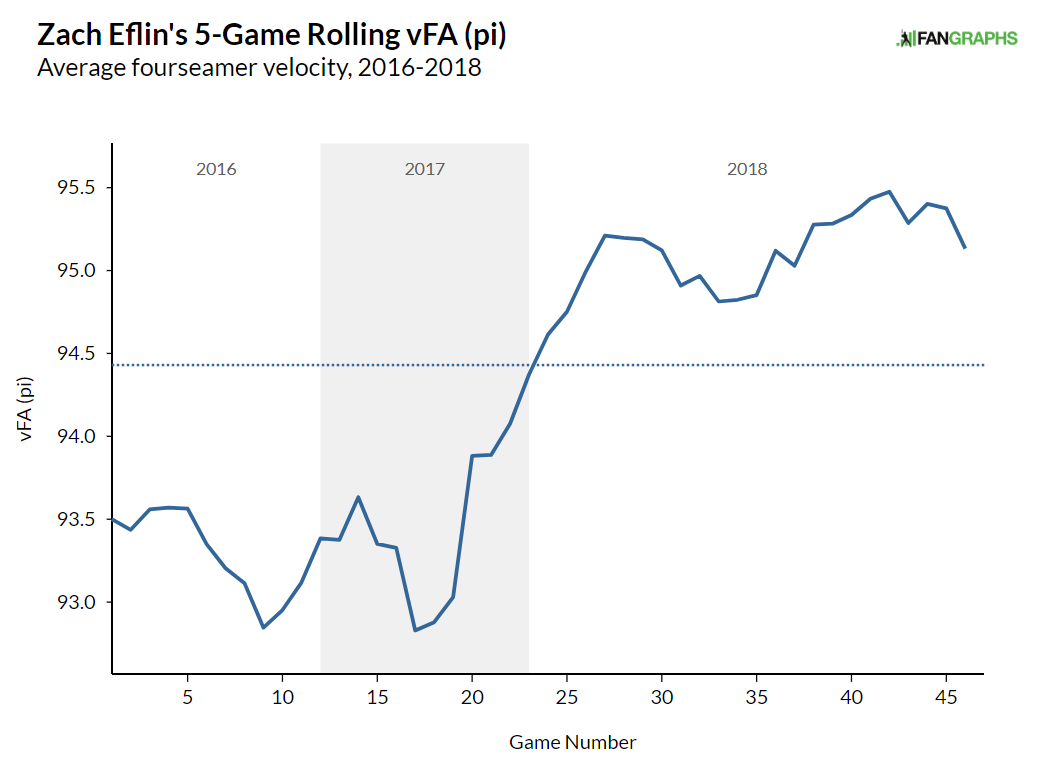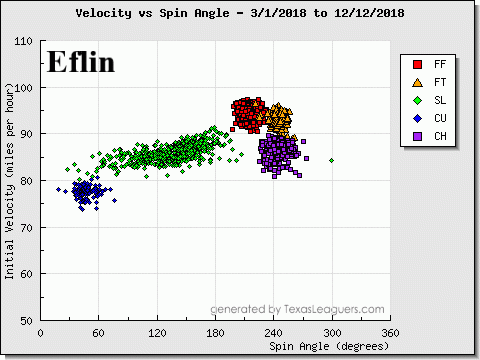Last season, Zach Eflin had something of a breakout for the Philadelphia Phillies. Jeff Sullivan, formerly of FanGraphs, properly attributed this to Eflin’s improved health. In summary, it had been around a dozen years since Eflin had been free of chronic pain in both of his knees, so he had surgery to correct this in 2017. After two miserable partial seasons, Eflin looked like an uninspiring pitch-to-contact pitcher. It wasn’t until 2018 that he was healthy enough to benefit from his procedures: He posted a respectable 2.2 WAR over 128.0 innings while shaving more than a point off of his SIERA and xFIP. For this reason — paired with a strong spring — Eflin looks set to be a contributing member of the Phillies’ starting rotation. More importantly, he looks good.
Eflin has undergone several changes. Some were more meaningful than others, but one stood out from the rest. From 2016 to 2018, Eflin’s fastball velocity:

After his fastball averaged in the 93s in 2016 and 2017, Eflin flirted with 95 mph throughout much of the year. This helped his fastball rise from a negative pVAL/C to a 0.01 pVAL/C, while his fastball xwOBA went from .416 and .381 to a much healthier .305. Fastballs are often integral in making a pitcher’s repertoire work and this is evidenced by Eflin’s ghastly 2016 and 2017. An improved fastball has been pivotal for his other offerings.
With an improved fastball, you would expect Eflin’s changeup to benefit. Eflin’s 2018 changeup:
| O-Swing% | Zone% | SwStr% | |
| Money Pitch | >40% | >40% | >15% |
| Eflin changeup | 38.6% | 38.7% | 11.8% |
Eflin could use a few more swings and misses in and out of the zone, but he’s flirting with a Money Pitch here. Even better, he had a .293 xwOBA on his slow ball, as well as a 34.1 Whiff% — the best of any of his pitches — and 23.2 K%.
(Quick note: There are some discrepancies in data and to be consistent I used all FanGraphs data above. However, Baseball Savant has Eflin’s O-Swing% and Zone% both above 40%. In that case, all he’s missing for his changeup is a few points on his SwStr% to be in Money Pitch territory.)
Now, these numbers all look fantastic, but the pitch itself did not perform so well. In fact, it was quite terrible: It got pummeled to the tune of a .396 wOBA and 155 wRC+.
Of course, his changeup is likely to regress closer to what it should have been in 2018. By xwOBA, it was twelfth unluckiest in the majors, per Alex Chamberlain’s amazing new pitch leaderboard. His changeup won’t maintain its .435 BABIP — that’s .159 higher than league average for changeups — and these numbers as an aggregate suggest that it should have far superior results in the future. Visually, it may not look like the best pitch, but the idea is that it plays off of his fastball. Eflin’s is much firmer than a typical changeup and thus lacks the sexiness of a Trevor Richards or prime Felix Hernandez changeup, for instance. You needn’t look further than Richards to see that even with the filthiest of changeups (and his is nasty) success is hard to come by without a good fastball.
He has multiple fastballs to work with, and they both work for him:
| O-Swing% | Zone% | SwStr% | |
| Money Pitch | >40% | >40% | >15% |
| Eflin sinker | 40.9% | 42.9% | 10.4% |
Again! Nearly a Money Pitch. His sinker meets two of three criteria for a Money Pitch and sports a serviceable .337 xwOBA — 14 points below league average — and my hunch is that his sinker gets more whiffs because of the presence of his slider: The pair play off of one another.
Lastly, a look at his 2018 slider numbers:
| O-Swing% | Zone% | SwStr% | |
| Money Pitch | >40% | >40% | >15% |
| Eflin slider | 35.5% | 47.1% | 12.5% |
Overall, his slider is nearly a Money Pitch. It’s missing some swings outside of the zone and some swinging strikes alike, but it has been his best pitch — good for a .254 xwOBA, 6.2 pVAL, and 1.3 pVAL/C.
To me, the most interesting thing about Eflin — other than a near-two mph increase on his fastball — is his slider. His other pitches are intriguing enough (Pitcher List’s own Nick Pollack touched on this over at RotoGraphs), but Eflin has shown a tendency to use multiple versions of his slider. Patrick Corbin has championed this concept more recently and I wrote about how Matthew Boyd is doing something similar. Now it appears Eflin is doing this with intention as well.
One version of his slider is more of a cutter and it sits anywhere from 87-91 mph:
You can see that there’s not any drastic break, but its disparity in velocity and movement from his four-seam and sinker helps it get swings and misses. Derek Dietrich simply stares at it. This version of his slider resembles a cutter so much so that in his last two games of 2018, Brooks Baseball began classifying it as a cutter. I think he could use this pitch more to get in on the fists of left-handed hitters since he struggles against them, but he has yet to make this change.
Eflin’s second slider sits more low-to-mid 80s, and looks much more like a conventional slider, albeit with much more vertical drop than any sweeping action.
At Brian Anderson’s swing decision point, the pitch looks like it’s going to catch the bottom of the strike zone. Then it falls out of the zone for a swinging strike and Anderson’s swing leaves him spun around the other way.
In many ways, Eflin resembles something like Zack Wheeler lite. Allow me to demonstrate with a handful of tables.
They feature and utilize similar pitches:
| FB% | SL% | CB% | CH/SF% | |
| Eflin | 58.2% | 25.2% | 5.4% | 11.1% |
| Wheeler | 58.2% | 19.2% | 10.5% | 12.0% |
I’ve combined Wheeler’s changeup and splitter, as they serve a similar function to Eflin’s changeup as a slower version of his fastballs. Not only do they use them similarly, but their pitches themselves aren’t dissimilar. Eflin and Wheeler’s velocity and spin, compared:

They’re different, but they’re similar enough. Wheeler throws all of his pitches a touch harder, which will always give him a slight advantage over Eflin. As I’ve talked about, you can see that Eflin’s slider is far more heterogeneous — and quite slower — than Wheeler’s. Wheeler also has a splitter that overlaps some with his changeup. Not unlike how Eflin has two sliders, Wheeler has two changeups.

Again, not too many differences here. Eflin gets a greater drop on his slider, while Wheeler’s typically doesn’t have as much depth. Between the two graphics, you can see that the biggest differences between the two pitchers are seen in Wheeler’s velocity and changeup variation and Eflin’s sliders.
Their repertoires are similar enough; let’s see how they shake out in outcome, then:
| K-BB% | ERA- | FIP- | xFIP- | SIERA | |
| Eflin | 15.7% | 109 | 92 | 99 | 4.02 |
| Wheeler | 16.7% | 87 | 81 | 94 | 3.87 |
Wheeler no doubt bests him here, but the differences are fewer than you think. The biggest advantage Wheeler has over Eflin is his 0.69 HR/9, while Eflin has a more typical HR/9, at 1.13. Since home runs are incredibly volatile, it wouldn’t be surprising to see these two sport much closer HR/9 numbers in 2019.
On batted balls:
| GB/FB | Exit Velocity | xwOBA | xwOBACON | BABIP | |
| Eflin | 1.08 | 86.0 | .296 | .354 | .309 |
| Wheeler | 1.25 | 84.7 | .279 | .326 | .279 |
Clearly, Wheeler flourishes on batted balls. Of players with 300 batted balls or more, Wheeler ranks seventh in xwOBA. This is in front of the likes of Dallas Keuchel, Wei-Yin Chen, Mike Foltynewicz, Dereck Rodriguez, and Jacob deGrom. Those names may not sound sexy — aside from deGrom, of course — but those pitchers make their living off of limiting contact (since they can’t miss bats). This is, in part, why Wheeler has a deflated BABIP and why his ERA has bested his FIP and SIERA. The latter should account for his batted ball profile, but it doesn’t appear to do its job here. Wheeler’s .273 wOBA and .279 xwOBA aren’t disparate enough to say Lady Luck has been on his side. Eflin isn’t so shabby himself; he merely has yet to distinguish himself as someone who can consistently generate soft contact. His numbers don’t pop like Wheeler’s, but his exit velocity is in the 85th percentile, while his Hard Hit percentage is in the 66th.
And of course, plate discipline:
| O-Swing% | Zone% | SwStr% | |
| Eflin | 30.6% | 46.5% | 10.3% |
| Wheeler | 33.5% | 43.4% | 10.7% |
Eflin lives in the zone more, but Wheeler gets more swings outside the zone. For Eflin, it’s encouraging to see a similar swinging strike rate to Wheeler, considering he’s younger and doesn’t have the velocity Wheeler has to set up his secondaries.
The comparison isn’t flawless. Wheeler has above average spin on his fastball and elite velocity for a starting pitcher. While Eflin’s velocity is quite solid, his spin rate leaves room to be desired and this is one reason there may always be a sizable difference between the two. Another area in which the duo differ is Wheeler’s is effectiveness against lefties. He has shown the ability to get in on the hands of lefties, while Eflin has chosen not to use the cutter version of his slider to do the same. It’s not out of the question to see Eflin see another rise in velocity (albeit smaller) and improving against lefties is something that will come with time and experimentation, but for now Eflin will always be a poor man’s Wheeler, because I do worry about the spin rate on his fastball.
Eflin doesn’t look like an ace, but the idea is that he can hit his second wind and have a breakout of sorts one more time. He’s got the fastball velocity, the command, and an assortment of secondary pitches with promise. He still struggles against lefties and he fades significantly each time through the order, but with the Phillies making several moves to bolster their bullpen, that’s less of a concern than it was in the past. Eflin is just shy of 25 years of age and yet he already appears to be an average MLB starter at the absolute minimum. That’s much more than you could have said in the past few years.
Graphic by Justin Paradis (@freshmeatcomm on Twitter)
All GIFs courtesy of Michael Augustine

